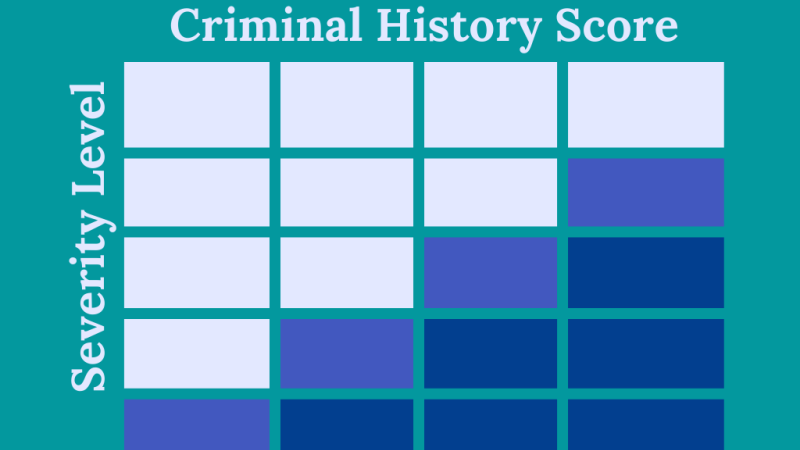While there are many ways to calculate guidelines sentences, one of the most popular approaches is to draft a sentencing guideline grid. Fourteen jurisdictions with active guidelines systems utilize at least one sentencing grid, nine utilize multiple grids that apply to different offenses (for example, drug crimes or sex crimes).
Overview of Sentencing Grid Design
Grids generally have two axes: one axis represents an offender’s criminal history, the other axis represents the severity of the current crime. At the intersection of the offender’s history and the offense severity, a cell on the grid will provide a sentence duration, or a range of possible sentence durations. The cell may also provide a sentence disposition, suggesting either incarceration or community-based correctional options. Some grids contain “border box” cells that suggest a choice be made between incarceration and/or community punishment depending on the case. Grids may also have disposition lines that demarcate the part of the grid where community correctional options end and incarceration options begin.
The term of years or the range of years given will increase with greater criminal history or greater offense severity. The type of punishment will also generally change from community-based sentencing for low-level offenses and few criminal convictions to prison-only sentencing for high-level offenses and recidivist offenders.
Variations in Sentencing Grids
There are many differences between jurisdictions in how sentenced are calculated. While the basic idea behind the grids is similar, these differences have a great impact in how offenders are actually sentenced from jurisdiction to jurisdiction. Here are some of the main differences between systems:
Number of separate grids
In some jurisdictions such as Arkansas and Oregon, one grid covers all crimes (or all felony crimes). In other jurisdictions, there are several grids that cover different types of crimes separately; for example, there may be a separate grid for drug offenses or sex offenses. In Michigan, which has the highest number of grids, there is a separate grid for each level of felony offense.
Number of “levels” or “points” on each grid axis
From Tennessee, which has a grid containing 25 cells, to the federal system, which has a grid containing 258 cells, there is great variety in how many separate cells an offender can fall into.
How much judicial discretion each cell allows
Some jurisdictions present a term of months or a very narrow range of months (i.e. 22-26 months) in each cell. Judges may be able to adjust the sentence by a certain number of months without departing, but the “grid” sentence is fairly specific. Other jurisdictions, for example, Washington D.C., offer a very wide range of durations from which judges may select an appropriate sentence (i.e. 36 to 78 months). In addition, some states, such as Kansas, employ border boxes in which more than one disposition option exists for the court to consider (i.e. prison, probation, etc.).
The degree of durational increase up/across the grid
How great the punishment increase is from cell to cell over the rise and run of the grid also varies between jurisdictions. Another feature that varies is whether, or to what degree, that increase is linear (e.g. a grid where each increase in offense severity level adds 5 years). In some jurisdictions, there may be non-linear increases or decreases in punishment at certain locations on the grid (i.e. the increase between a “3” and a ”4” in offense severity is 5 years, but the increase between a “4” and a “5” is 10 years).[1]
The way in which the offense score is calculated
Some jurisdictions have a simple table system in which each crime is assigned a place on the continuum of less serious to more serious. Other jurisdictions have much more complex offense score calculations; for example, in Michigan (where each crime level already has its own worksheet) the offense variable is based on details of the crime and has to do with factors like physical injury to the victim or that the offense is part of a continuing pattern of criminal behavior. Similarly, in the federal system, offense severity starts with a “base” offense number and then other factors are considered to adjust that number up or down.
The way in which the criminal history score is calculated
Criminal history is based on a points system in many jurisdictions. However, in a handful of jurisdictions with grids (Delaware, Kansas, Massachusetts, Oregon, and Tennessee) offenders are assigned a criminal history category which may or may not place offenders on a similar part of the grid as a score would. In both types of jurisdictions, which offenses are considered part of current criminal history varies. Some jurisdictions, for example, allow crimes to “wash out” of the calculation after a certain number of years or do not count juvenile adjudications. For more information about criminal history calculations, reference the Criminal History Enhancements Sourcebook.
Advantages of Sentencing Grids
Another advantage of sentencing grids is their ability to help systems adapt to innovations in sentencing. For example, Minnesota experienced recent reforms in drug sentencing policy under the Drug Reform Act of 2016. In response, the Commission adopted a new grid specifically for drug offenses and therefore went from utilizing two grids to three. The drug crime grid was distributed as the new law went into effect, and helped practitioners implement the statutory changes in courtrooms.[4]
Disadvantages of Sentencing Grids
Grids are favored for their simplicity in presentation, but in some systems (in particular the federal system) this is not the case.[5] As the table shows, the federal guidelines are displayed in a 43 severity level grid with 6 criminal history categories. Without taking into account sentences that depart from the guidelines or other considerations, there are 258 sentencing possibilities presented. It is possible that some sentencing schemes are too complex to be represented through a grid, and this may be the case with the federal guidelines.
Due to the nature of their design, grids may also over-emphasize the importance of criminal history and the severity of the offense in sentencing. Some grids may emphasize a linear or, at any rate, positive relationship between the two variables.[6] One danger of these emphases is that they may obscure the more intricate goals of sentencing. There may also be hidden complications in the way in which a grid operates that create disparate sentencing by race or other offender characteristics. These problems can be difficult to detect without sentencing data analysis and keen study.[7]

